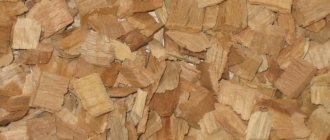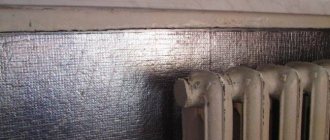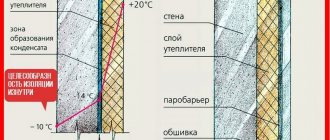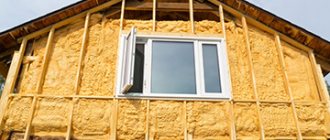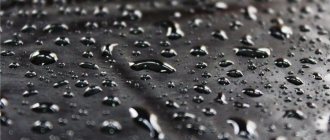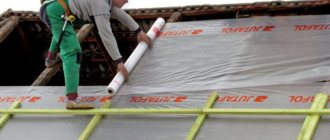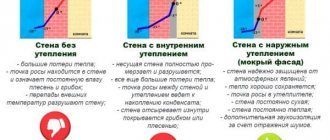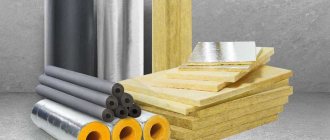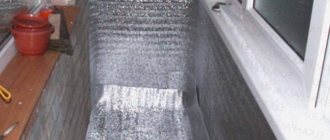Material selection
There are a number of requirements for thermal insulation materials.
The insulation must have low thermal conductivity, good hygroscopicity, fire safety and environmental friendliness.
It is necessary that the material reliably prevents heat exchange between the external and internal parts of the walls and protects the structure well from the inside.
Today, mineral wool based on basalt or fiberglass is widely used as insulation. If the ventilation of the house is properly equipped, moisture will not be a problem for this material.
New products for high-quality do-it-yourself insulation of a dacha are constantly appearing on the construction goods market. For example:
- insulation made of flax fiber - the material is produced in slabs, is easy to cut, does not change shape, is environmentally friendly, has good antiseptic properties;
- ecowool is a sprayed loose heat insulator consisting of recycled cellulose with the addition of antiseptics and fire retardants;
- soft fiberboard (fiberboard) is an environmentally friendly material that can be used to immediately strengthen walls.
How and with what to insulate is a matter of taste and good choice. The main thing is that the country house is reliably protected from the winter cold.
Insulation of the dacha
The design of a country house is usually intended to be used during the warm season. The main task is protection from precipitation, wind and dust.
During the cold season, it becomes impossible to live in a country house; it is not able to sufficiently provide a comfortable temperature. You have to constantly heat the stove or boiler, keep electric heaters on, which creates increased consumption of energy, fuel and, accordingly, money.
Let's look at how to insulate a country house for winter living and solve the problem with your own hands.
Why insulate?
Insulating a country house for year-round use automatically turns it into a full-fledged home. The fashion for country houses has been around for quite some time, and insulating a dacha makes it possible to acquire such a home relatively inexpensively and easily. The possibility of year-round living outside the city limits, in the fresh air, is attractive to most owners of country houses.
In addition to considerations of economy, insulating a country house with your own hands has another, more important reason. When people live permanently, the house develops its own atmosphere, saturated with water vapor. They appear due to cooking, using the bathroom, toilet. But the main amount of steam appears due to people's breathing. The steam that comes out of your mouth in the cold is also released when you breathe in warm rooms, it’s just not visible. In the internal atmosphere of a house, steam is under a certain pressure, which is called partial pressure. Normally, this moisture is gradually pressed through the walls and removed outside, evaporating from the outer surface of the walls.
If the structure of the house is not designed for living in winter, the surfaces of the walls are not able to retain heat. They are constantly cold, which causes steam to condense on them. The walls get wet, become saturated with water, freeze on the outside and begin to collapse. Metal elements begin to rust and fail.
Insulating the dacha for winter living will help to avoid this, which consists of installing a heat insulator on the surface of the external walls, ceilings, floor and (if required) roof.
Roof
If installed incorrectly, a roof can “steal” more than 10% of the heat spent on heating the house.
When choosing thermal insulation for a roof, pay attention to its service life, which depends on many external factors: temperature fluctuations, amount of precipitation (especially snow), wind strength and direction. Pay special attention to the water resistance of the material. Isolation must also be safe for health. The first sign of safe insulation is the absence of a sharp, pungent odor.
Insulating the roof with polymer materials is not the best solution. They ignite very easily and quickly, so increased fire safety measures will have to be taken.
The best insulation for roofing can be considered stone wool, which is intended for thermal protection of structures that do not bear heavy loads.
Walls
Insulation of walls is the main stage of work, since they occupy the main area of any building and have the highest heat transfer.
Surface preparation
Before insulating wooden walls, be sure to clean the entire surface of dirt. Carefully treat the inside of the walls with special solutions and aerosols that will protect the wood from insects. Then caulk all the gaps using dry tow and a thin chisel.
Insulation
Jute fabric is very suitable as a heat insulator for walls. It is quickly and easily laid with a construction stapler, does not rot, is not blown away by the wind and is not of interest to moths. Tow and jute fiber have low thermal conductivity due to their capillary structure and easily release moisture. In addition, as bactericidal materials, they successfully resist the spread of fungus.
It is not recommended to use improvised materials to insulate the walls of a country house: felt, batting, wool. They accumulate moisture abundantly. As a result, the process of rotting quickly begins, and moths are sure to appear in the wool.
Some rules for carrying out thermal insulation work at the dacha
Of course, the price of the material also influences the choice of the type or brand of insulation, but, in addition, it should be taken into account that materials for its installation will also be required, the cost of which can significantly offset the economic benefit of purchasing a cheaper insulator.
Installation of thermal insulation material can be done in different ways, but insulating a house from the inside is best done using special adhesive compositions intended for this type of work, as well as fastening elements: dowels, including umbrella dowels, self-tapping screws and even nails.
But in some cases, this set will not be enough and it will be necessary to construct a sheathing, which not only serves as a basis for laying insulation, but also acts as a ventilation gap to allow condensate to evaporate. In such cases, the use of a vapor barrier film is also required, which simultaneously serves to protect the thermal insulation material from getting wet and to freely drain condensate.
Laying a diffuse vapor barrier film can be done both between the insulation and the outer layer of finishing, and additionally between the outer wall and the heat-insulating material.
The choice of method is determined by the material from which the walls of the house are built, as well as the type of insulation itself.
In some cases, protection from moisture is required not only for the latter, but also for the walls themselves, which may begin to collapse as a result of constant exposure to moisture. This factor is especially important when thermally insulating wooden houses and especially if the walls are insulated from the inside with penoplex - a material with low thermal conductivity, which allows the use of products of small thickness, but with almost zero vapor permeability, which in a particular case can be dangerous for a log house.
Prevention of problems associated with the formation of cold bridges
During work, it is important to correctly lay the thermal insulation material, without allowing even a millimeter of bare wall - neglecting this rule will lead to the formation of cold bridges through which heat will freely flow out and cold air in, and in addition, such places become areas where Condensation actively forms, and then mold appears.
The formation of cold bridges can also be caused by fastening elements, and this is especially noticeable in the example of wooden houses, for which the use of metal parts is undesirable.
If possible, it is recommended to use wooden elements that have the same thermal conductivity, and if it is necessary to use metal ones, insulate the latter, for example, with wooden or plastic parts, as well as with the use of thermal insulation materials.
Window
After insulating the walls, we move on to the windows. They also lead to significant heat loss, so close attention should be paid to windows, especially if the design is outdated.
Cleaning and waterproofing
The frames of the house should be thoroughly cleaned of dust, cracked glass should be replaced, and the gaps between the walls and frames should be sealed.
For high-quality insulation you will need silicone sealant in a special gun. It reliably protects joints from the inside from fungi and mold.
Polyurethane foam will also work. However, it quickly deteriorates from the sun and is not entirely aesthetically pleasing. If you choose foam, you will have to take measures to protect it from ultraviolet rays.
D-profile tape
Then you need to glue the sealing tape. D-profile tape is best suited. It effectively closes gaps up to 7 mm. For a more secure fixation, you can secure the tape with nails or staples.
Film on glass and insulation of slopes
To maximize the insulation of windows, cover them with heat-saving film. This material is applied directly to the glass. When laying the film there should be no folds, swelling or bubbles. Carefully done work will help save more than 30% of heat.
Don't forget about insulating the slopes. For this, you can use various materials, for example, polyethylene foam or mineral wool. The insulation is fixed to the slopes using glue.
Tips for choosing insulation
Tip 1.
Be sure to take into account what material the house is built from. If for wooden buildings the air permeability of the heat insulator is fundamentally important, then for buildings made of brick or foam concrete this parameter is not so critical.
Tip 2.
The moisture resistance of a building material is an important criterion for choosing suitable thermal insulation for walls in a country house. Consider whether the building will be heated in winter. The likelihood of condensation forming due to the difference in temperature outside and in the house depends on this, which will subsequently contribute to the soaking of the insulating layer, and it will quickly collapse and lose its functionality.
This problem can be avoided if you use a special vapor barrier film to protect the insulation from moisture.
Floor
There are many modern materials for floor insulation. The main thing is that the inside of the country house is as dry as possible.
Styrofoam
Expanded polystyrene does not absorb moisture, is durable, strong, and a good antiseptic. It is convenient to work with such material because it does not change the original volume.
Minvata
Mineral wool is sold in various versions: rolls, slabs, mats. Low density, environmental friendliness, wear resistance, relatively low price are its main advantages.
Penofol
The new material penofol has already shown its best side and has gained popularity. It is sold in rolls consisting of a layer of foil and insulation. Most often, the base is foamed polyethylene.
Requirements for insulation
When choosing a material for insulating a dacha floor with your own hands, do not look for the cheapest options and be sure to remember that the insulation must be:
- environmentally friendly, safe for health;
- excellent heat insulator;
- durable.
Which insulation to choose for your dacha?
When choosing insulation for a summer house, we must pay attention, first of all, to:
- Thermal resistance - indicated on the packaging by the letter R and is inextricably linked with the thickness of the material. The thicker it is, the higher the thermal resistance;
- Heat transfer coefficient - determined by the symbol λ. This is a very important parameter because it shows whether the material we have chosen is suitable for thermal insulation. It should be remembered that the lower the thermal conductivity coefficient, the better - the heat losses of the house will be lower (pay attention to the value of W / mK);
- Heat transfer coefficient - in this case we are dealing with the letter U. This parameter is similar to thermal conductivity, but is more accurate. Its correct analysis will allow us to find out how much heat will penetrate through the wall. Insulation materials with the lowest possible coefficient should be selected.
Floor insulation methods
There are several ways to insulate the floor of a country house.
Double floor
The bottom layer of rough boards is carefully attached directly to the beams. A “finish” coating is laid on the “rough” structure.
Floor insulation using joists
Wooden logs are installed on the foundation in increments of 0.5–1 m or cut into the frame. Next, the “rough” floor is laid. The free space is filled with thermal insulation. Quite a simple and effective way. You can insulate the floor using joists installed on brick columns. Any insulation: mineral wool, fiberglass, polystyrene foam or other suitable material. The distance between the finished floor and the ground increases. The work does not require builder experience and can be easily done with your own hands. With this option, the insulating material does not experience stress, which makes the method of insulating a wooden floor along joists ideal.
How best to insulate
There are two ways:
- insulation of a country house from the inside
- insulation of a country house from the outside
External insulation is considered the most effective and preferable option. It consists of installing a heat insulator on the outside of the walls and has many advantages:
- The inner surface of the walls is kept intact , which allows you to finish it in any way, install hanging furniture or household appliances
- all conditions are maintained for the unhindered release of water vapor , the durability and safety of wall materials and structures is ensured
- walls are included in the thermal contour of the building, which contributes to more efficient operation
The disadvantages of external insulation include:
- work cannot be carried out in frost , rain or darkness
- not all types of insulation are suitable for outdoor installation
Insulation from the inside involves installing heat insulators on the inside. The room becomes as if enclosed in a cocoon of insulating material installed on all external walls. The disadvantages of this method are:
- the escape of steam through the walls becomes more difficult or even
- the surface of the walls is covered with insulation, requiring the installation of protective sheathing or another layer
- installation of hanging objects on the walls is excluded
- the volume of rooms is reduced
- external walls are excluded from the thermal contour , remaining only mechanical fences
The advantages include:
- ability to carry out work at any time or in any weather
- there is free access to any surfaces
The main difference between these methods is the steam output mode. With external insulation, it passes through the wall, enters the insulation, from where it is removed outside. It is necessary to use a vapor-permeable insulator, the most successful option of which is mineral wool. With internal insulation, steam escape becomes almost impossible. If an impermeable insulator is used, cutoff occurs. If mineral wool is installed, then the steam passing through it ends up in front of the wall. Its permeability is lower than that of the insulator, so steam accumulates in the thickness of the insulation, the material becomes wet and loses its working qualities.
Vapor permeability rule
There is a rule according to which the vapor permeability of materials should increase in the direction from inside to outside. According to him, installing an impermeable insulator on the outside will “lock” the vapors inside the wall, causing it to become wet and begin to deteriorate.
At the same time, installing permeable material on the inside will create conditions for vapor absorption by the insulator, but will prevent passage through the wall. Guided by this rule, you can avoid common mistakes when choosing and installing heat insulators.
When choosing an installation method, you should definitely prefer the outdoor option. However, sometimes you have to choose internal insulation if there is no possibility or access to the surface of the walls. For example, you cannot disturb the architecture of the house, or the walls are located too close to the neighboring building, etc. When choosing internal insulation , you should immediately take care of creating a high-quality ventilation system . The removal of internal air will remove steam, which will eliminate the problem of excessive air humidity.
